Worst Job Experience: Analysis, JCM Redesign and Justification
VerifiedAdded on 2022/08/11
|9
|2197
|24
Essay
AI Summary
This essay delves into a student's experience as a deputy manager in a retail store, highlighting the negative aspects of the job that led to demotivation and dissatisfaction. The student applies the Job Characteristics Model (JCM) to analyze the shortcomings of the role, specifically focusing on the lack of skill variety, task identity, task significance, autonomy, and feedback. The essay then proposes a redesigned job description that incorporates the five core dimensions of the JCM to enhance employee motivation, job satisfaction, and overall work outcomes. The redesigned role emphasizes the delegation of tasks, employee engagement, and the implementation of a feedback system. The analysis concludes that the original job lacked essential elements for employee well-being and that the proposed redesign offers a path to a more fulfilling and productive work environment, aligning with the principles of effective leadership and management.
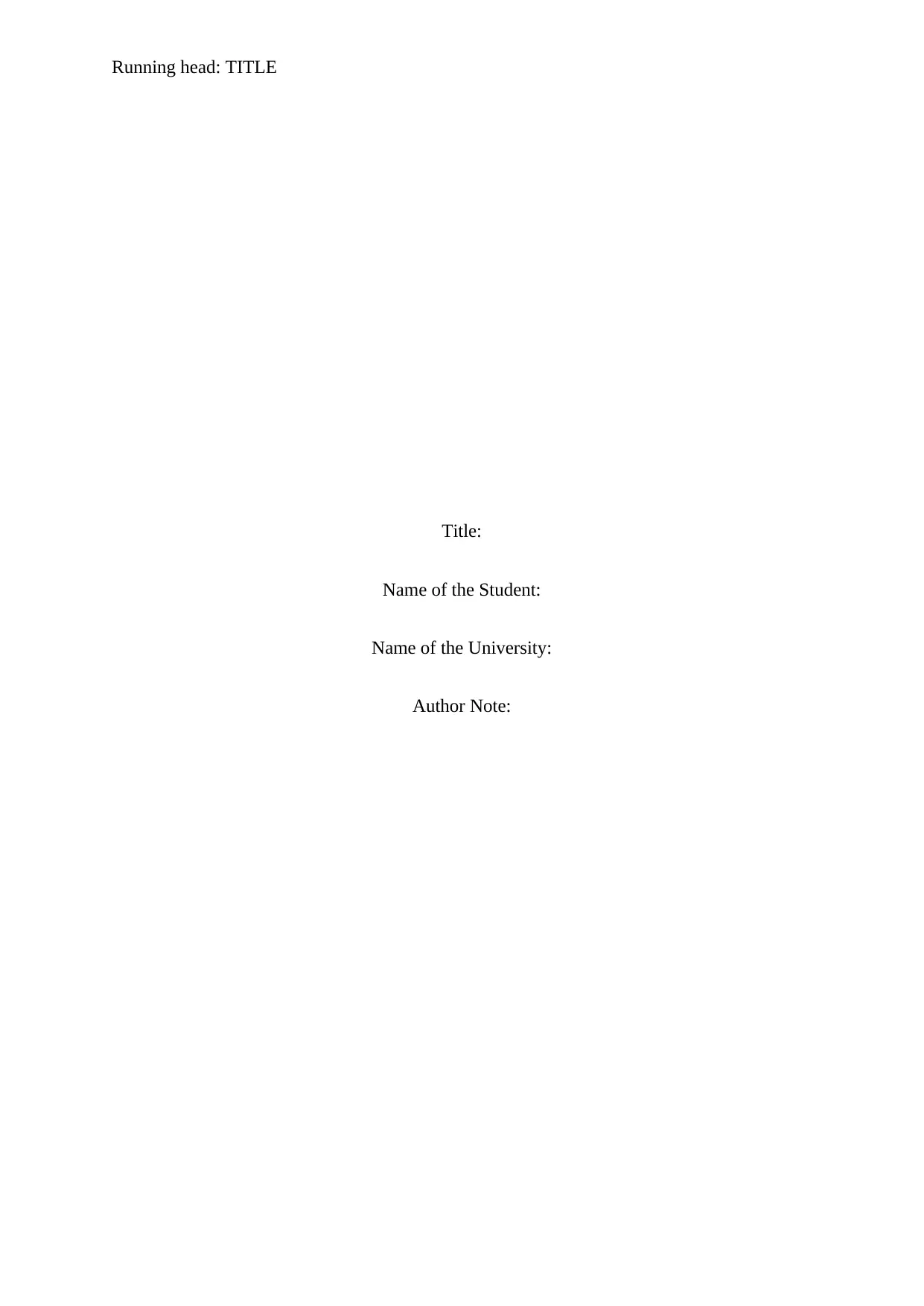
Running head: TITLE
Title:
Name of the Student:
Name of the University:
Author Note:
Title:
Name of the Student:
Name of the University:
Author Note:
Paraphrase This Document
Need a fresh take? Get an instant paraphrase of this document with our AI Paraphraser
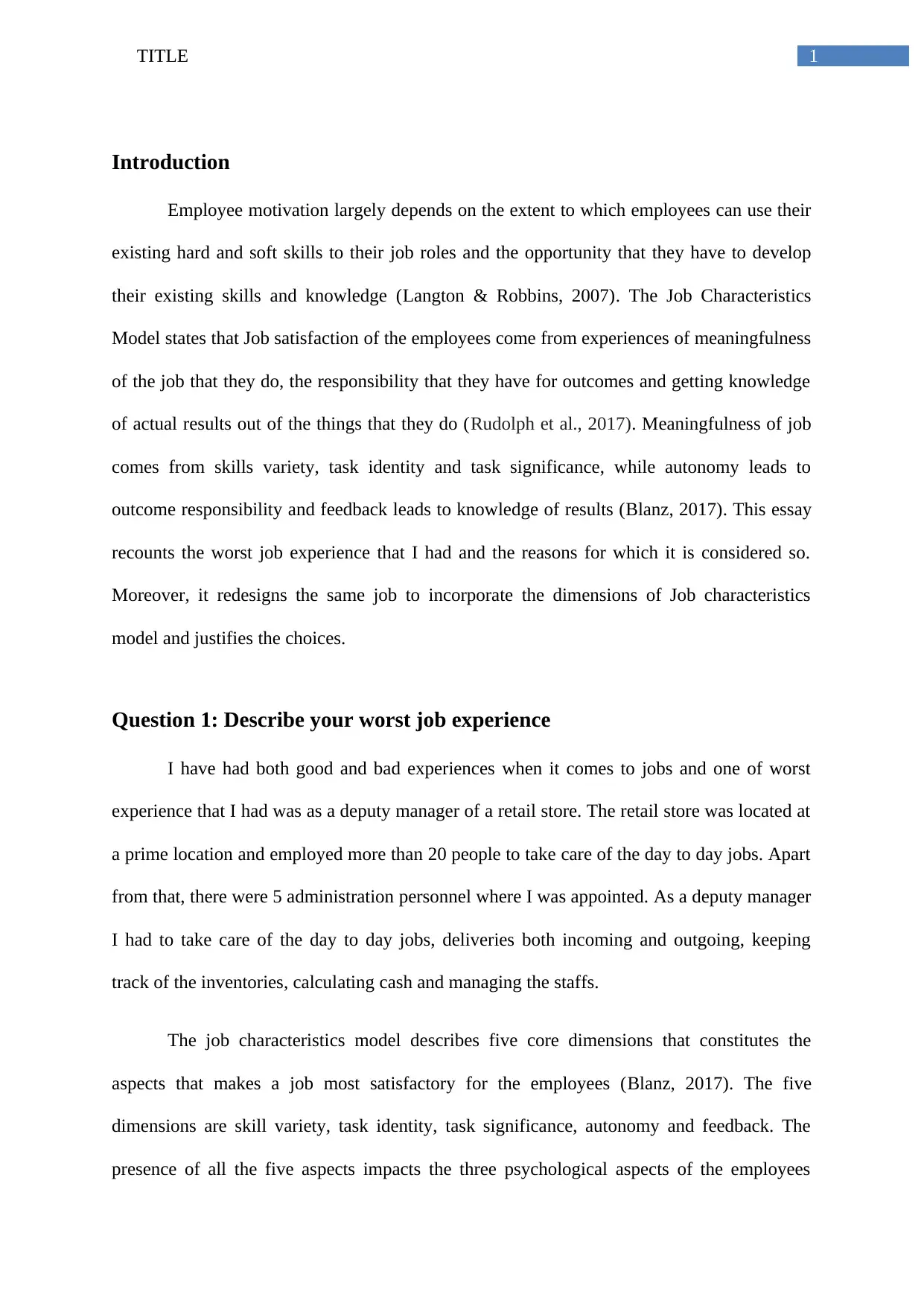
1TITLE
Introduction
Employee motivation largely depends on the extent to which employees can use their
existing hard and soft skills to their job roles and the opportunity that they have to develop
their existing skills and knowledge (Langton & Robbins, 2007). The Job Characteristics
Model states that Job satisfaction of the employees come from experiences of meaningfulness
of the job that they do, the responsibility that they have for outcomes and getting knowledge
of actual results out of the things that they do (Rudolph et al., 2017). Meaningfulness of job
comes from skills variety, task identity and task significance, while autonomy leads to
outcome responsibility and feedback leads to knowledge of results (Blanz, 2017). This essay
recounts the worst job experience that I had and the reasons for which it is considered so.
Moreover, it redesigns the same job to incorporate the dimensions of Job characteristics
model and justifies the choices.
Question 1: Describe your worst job experience
I have had both good and bad experiences when it comes to jobs and one of worst
experience that I had was as a deputy manager of a retail store. The retail store was located at
a prime location and employed more than 20 people to take care of the day to day jobs. Apart
from that, there were 5 administration personnel where I was appointed. As a deputy manager
I had to take care of the day to day jobs, deliveries both incoming and outgoing, keeping
track of the inventories, calculating cash and managing the staffs.
The job characteristics model describes five core dimensions that constitutes the
aspects that makes a job most satisfactory for the employees (Blanz, 2017). The five
dimensions are skill variety, task identity, task significance, autonomy and feedback. The
presence of all the five aspects impacts the three psychological aspects of the employees
Introduction
Employee motivation largely depends on the extent to which employees can use their
existing hard and soft skills to their job roles and the opportunity that they have to develop
their existing skills and knowledge (Langton & Robbins, 2007). The Job Characteristics
Model states that Job satisfaction of the employees come from experiences of meaningfulness
of the job that they do, the responsibility that they have for outcomes and getting knowledge
of actual results out of the things that they do (Rudolph et al., 2017). Meaningfulness of job
comes from skills variety, task identity and task significance, while autonomy leads to
outcome responsibility and feedback leads to knowledge of results (Blanz, 2017). This essay
recounts the worst job experience that I had and the reasons for which it is considered so.
Moreover, it redesigns the same job to incorporate the dimensions of Job characteristics
model and justifies the choices.
Question 1: Describe your worst job experience
I have had both good and bad experiences when it comes to jobs and one of worst
experience that I had was as a deputy manager of a retail store. The retail store was located at
a prime location and employed more than 20 people to take care of the day to day jobs. Apart
from that, there were 5 administration personnel where I was appointed. As a deputy manager
I had to take care of the day to day jobs, deliveries both incoming and outgoing, keeping
track of the inventories, calculating cash and managing the staffs.
The job characteristics model describes five core dimensions that constitutes the
aspects that makes a job most satisfactory for the employees (Blanz, 2017). The five
dimensions are skill variety, task identity, task significance, autonomy and feedback. The
presence of all the five aspects impacts the three psychological aspects of the employees
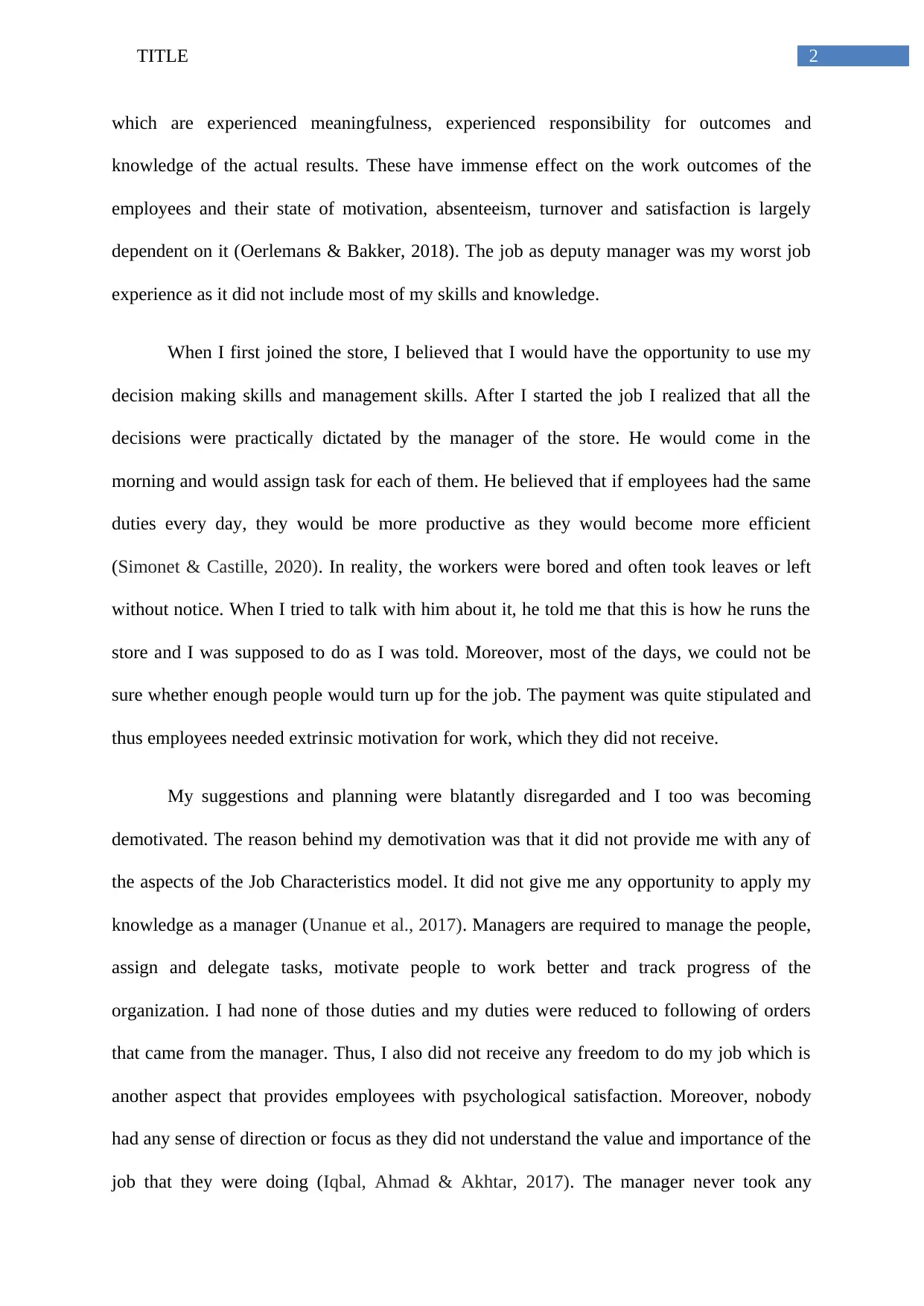
2TITLE
which are experienced meaningfulness, experienced responsibility for outcomes and
knowledge of the actual results. These have immense effect on the work outcomes of the
employees and their state of motivation, absenteeism, turnover and satisfaction is largely
dependent on it (Oerlemans & Bakker, 2018). The job as deputy manager was my worst job
experience as it did not include most of my skills and knowledge.
When I first joined the store, I believed that I would have the opportunity to use my
decision making skills and management skills. After I started the job I realized that all the
decisions were practically dictated by the manager of the store. He would come in the
morning and would assign task for each of them. He believed that if employees had the same
duties every day, they would be more productive as they would become more efficient
(Simonet & Castille, 2020). In reality, the workers were bored and often took leaves or left
without notice. When I tried to talk with him about it, he told me that this is how he runs the
store and I was supposed to do as I was told. Moreover, most of the days, we could not be
sure whether enough people would turn up for the job. The payment was quite stipulated and
thus employees needed extrinsic motivation for work, which they did not receive.
My suggestions and planning were blatantly disregarded and I too was becoming
demotivated. The reason behind my demotivation was that it did not provide me with any of
the aspects of the Job Characteristics model. It did not give me any opportunity to apply my
knowledge as a manager (Unanue et al., 2017). Managers are required to manage the people,
assign and delegate tasks, motivate people to work better and track progress of the
organization. I had none of those duties and my duties were reduced to following of orders
that came from the manager. Thus, I also did not receive any freedom to do my job which is
another aspect that provides employees with psychological satisfaction. Moreover, nobody
had any sense of direction or focus as they did not understand the value and importance of the
job that they were doing (Iqbal, Ahmad & Akhtar, 2017). The manager never took any
which are experienced meaningfulness, experienced responsibility for outcomes and
knowledge of the actual results. These have immense effect on the work outcomes of the
employees and their state of motivation, absenteeism, turnover and satisfaction is largely
dependent on it (Oerlemans & Bakker, 2018). The job as deputy manager was my worst job
experience as it did not include most of my skills and knowledge.
When I first joined the store, I believed that I would have the opportunity to use my
decision making skills and management skills. After I started the job I realized that all the
decisions were practically dictated by the manager of the store. He would come in the
morning and would assign task for each of them. He believed that if employees had the same
duties every day, they would be more productive as they would become more efficient
(Simonet & Castille, 2020). In reality, the workers were bored and often took leaves or left
without notice. When I tried to talk with him about it, he told me that this is how he runs the
store and I was supposed to do as I was told. Moreover, most of the days, we could not be
sure whether enough people would turn up for the job. The payment was quite stipulated and
thus employees needed extrinsic motivation for work, which they did not receive.
My suggestions and planning were blatantly disregarded and I too was becoming
demotivated. The reason behind my demotivation was that it did not provide me with any of
the aspects of the Job Characteristics model. It did not give me any opportunity to apply my
knowledge as a manager (Unanue et al., 2017). Managers are required to manage the people,
assign and delegate tasks, motivate people to work better and track progress of the
organization. I had none of those duties and my duties were reduced to following of orders
that came from the manager. Thus, I also did not receive any freedom to do my job which is
another aspect that provides employees with psychological satisfaction. Moreover, nobody
had any sense of direction or focus as they did not understand the value and importance of the
job that they were doing (Iqbal, Ahmad & Akhtar, 2017). The manager never took any
⊘ This is a preview!⊘
Do you want full access?
Subscribe today to unlock all pages.

Trusted by 1+ million students worldwide
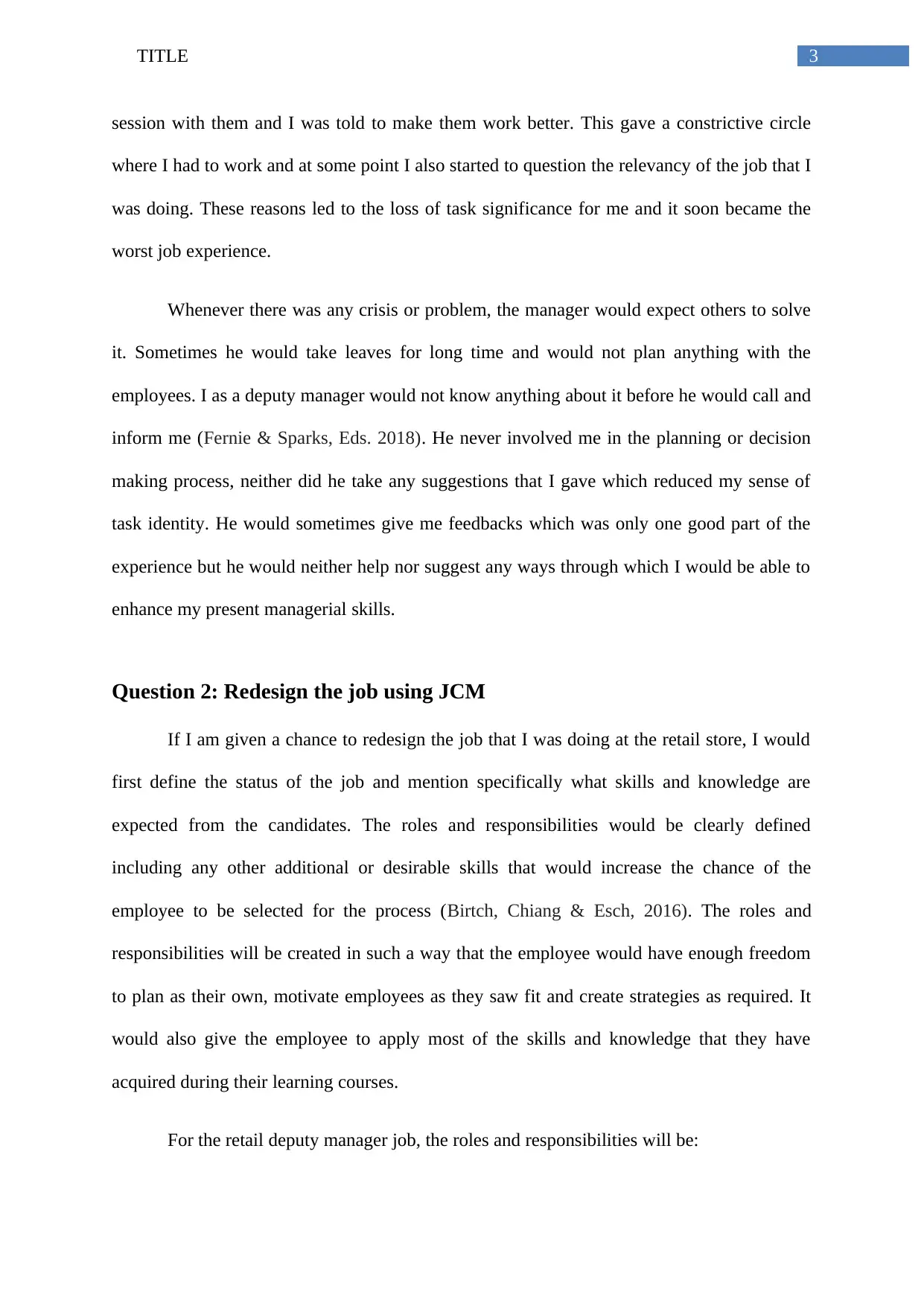
3TITLE
session with them and I was told to make them work better. This gave a constrictive circle
where I had to work and at some point I also started to question the relevancy of the job that I
was doing. These reasons led to the loss of task significance for me and it soon became the
worst job experience.
Whenever there was any crisis or problem, the manager would expect others to solve
it. Sometimes he would take leaves for long time and would not plan anything with the
employees. I as a deputy manager would not know anything about it before he would call and
inform me (Fernie & Sparks, Eds. 2018). He never involved me in the planning or decision
making process, neither did he take any suggestions that I gave which reduced my sense of
task identity. He would sometimes give me feedbacks which was only one good part of the
experience but he would neither help nor suggest any ways through which I would be able to
enhance my present managerial skills.
Question 2: Redesign the job using JCM
If I am given a chance to redesign the job that I was doing at the retail store, I would
first define the status of the job and mention specifically what skills and knowledge are
expected from the candidates. The roles and responsibilities would be clearly defined
including any other additional or desirable skills that would increase the chance of the
employee to be selected for the process (Birtch, Chiang & Esch, 2016). The roles and
responsibilities will be created in such a way that the employee would have enough freedom
to plan as their own, motivate employees as they saw fit and create strategies as required. It
would also give the employee to apply most of the skills and knowledge that they have
acquired during their learning courses.
For the retail deputy manager job, the roles and responsibilities will be:
session with them and I was told to make them work better. This gave a constrictive circle
where I had to work and at some point I also started to question the relevancy of the job that I
was doing. These reasons led to the loss of task significance for me and it soon became the
worst job experience.
Whenever there was any crisis or problem, the manager would expect others to solve
it. Sometimes he would take leaves for long time and would not plan anything with the
employees. I as a deputy manager would not know anything about it before he would call and
inform me (Fernie & Sparks, Eds. 2018). He never involved me in the planning or decision
making process, neither did he take any suggestions that I gave which reduced my sense of
task identity. He would sometimes give me feedbacks which was only one good part of the
experience but he would neither help nor suggest any ways through which I would be able to
enhance my present managerial skills.
Question 2: Redesign the job using JCM
If I am given a chance to redesign the job that I was doing at the retail store, I would
first define the status of the job and mention specifically what skills and knowledge are
expected from the candidates. The roles and responsibilities would be clearly defined
including any other additional or desirable skills that would increase the chance of the
employee to be selected for the process (Birtch, Chiang & Esch, 2016). The roles and
responsibilities will be created in such a way that the employee would have enough freedom
to plan as their own, motivate employees as they saw fit and create strategies as required. It
would also give the employee to apply most of the skills and knowledge that they have
acquired during their learning courses.
For the retail deputy manager job, the roles and responsibilities will be:
Paraphrase This Document
Need a fresh take? Get an instant paraphrase of this document with our AI Paraphraser
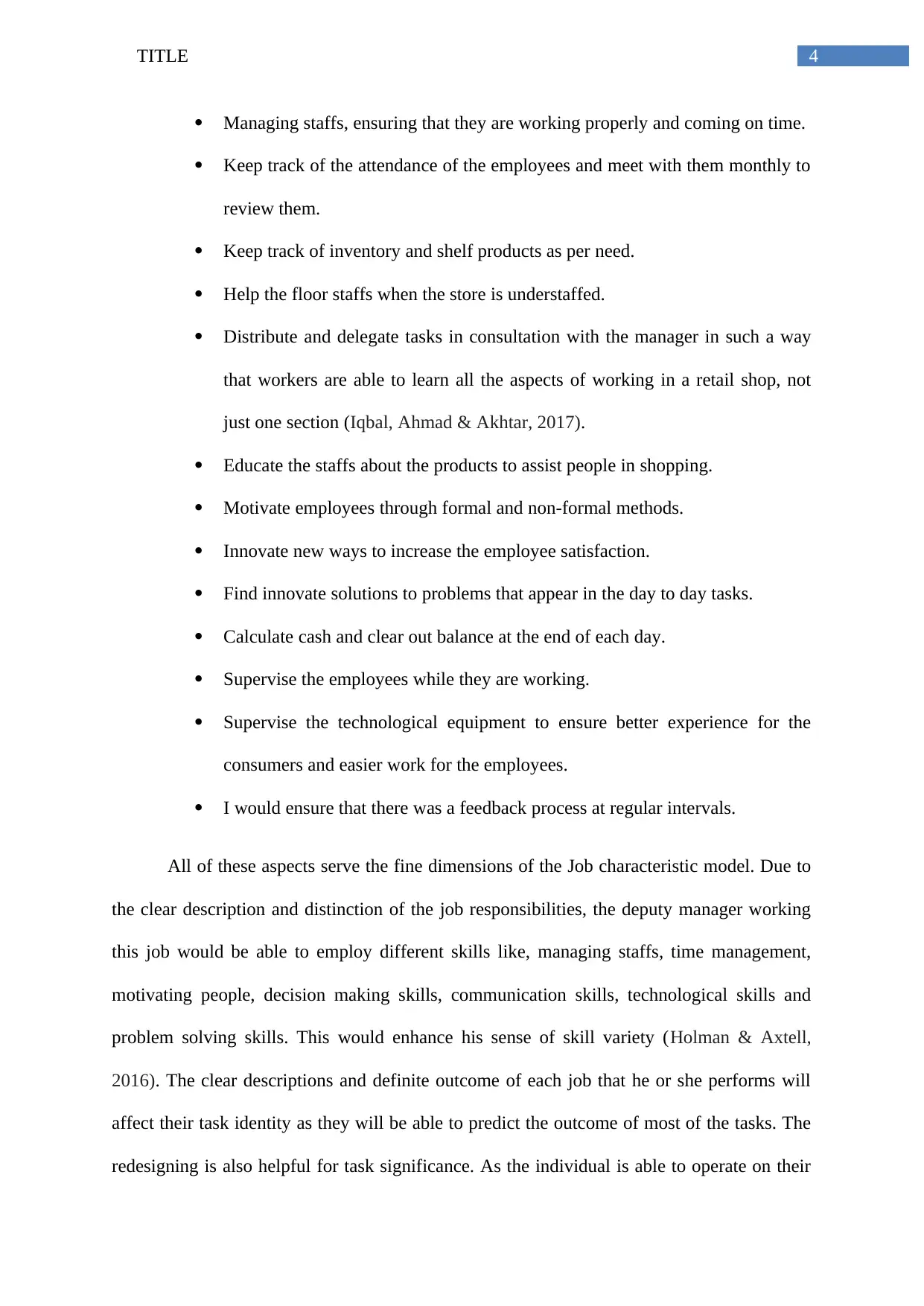
4TITLE
Managing staffs, ensuring that they are working properly and coming on time.
Keep track of the attendance of the employees and meet with them monthly to
review them.
Keep track of inventory and shelf products as per need.
Help the floor staffs when the store is understaffed.
Distribute and delegate tasks in consultation with the manager in such a way
that workers are able to learn all the aspects of working in a retail shop, not
just one section (Iqbal, Ahmad & Akhtar, 2017).
Educate the staffs about the products to assist people in shopping.
Motivate employees through formal and non-formal methods.
Innovate new ways to increase the employee satisfaction.
Find innovate solutions to problems that appear in the day to day tasks.
Calculate cash and clear out balance at the end of each day.
Supervise the employees while they are working.
Supervise the technological equipment to ensure better experience for the
consumers and easier work for the employees.
I would ensure that there was a feedback process at regular intervals.
All of these aspects serve the fine dimensions of the Job characteristic model. Due to
the clear description and distinction of the job responsibilities, the deputy manager working
this job would be able to employ different skills like, managing staffs, time management,
motivating people, decision making skills, communication skills, technological skills and
problem solving skills. This would enhance his sense of skill variety (Holman & Axtell,
2016). The clear descriptions and definite outcome of each job that he or she performs will
affect their task identity as they will be able to predict the outcome of most of the tasks. The
redesigning is also helpful for task significance. As the individual is able to operate on their
Managing staffs, ensuring that they are working properly and coming on time.
Keep track of the attendance of the employees and meet with them monthly to
review them.
Keep track of inventory and shelf products as per need.
Help the floor staffs when the store is understaffed.
Distribute and delegate tasks in consultation with the manager in such a way
that workers are able to learn all the aspects of working in a retail shop, not
just one section (Iqbal, Ahmad & Akhtar, 2017).
Educate the staffs about the products to assist people in shopping.
Motivate employees through formal and non-formal methods.
Innovate new ways to increase the employee satisfaction.
Find innovate solutions to problems that appear in the day to day tasks.
Calculate cash and clear out balance at the end of each day.
Supervise the employees while they are working.
Supervise the technological equipment to ensure better experience for the
consumers and easier work for the employees.
I would ensure that there was a feedback process at regular intervals.
All of these aspects serve the fine dimensions of the Job characteristic model. Due to
the clear description and distinction of the job responsibilities, the deputy manager working
this job would be able to employ different skills like, managing staffs, time management,
motivating people, decision making skills, communication skills, technological skills and
problem solving skills. This would enhance his sense of skill variety (Holman & Axtell,
2016). The clear descriptions and definite outcome of each job that he or she performs will
affect their task identity as they will be able to predict the outcome of most of the tasks. The
redesigning is also helpful for task significance. As the individual is able to operate on their
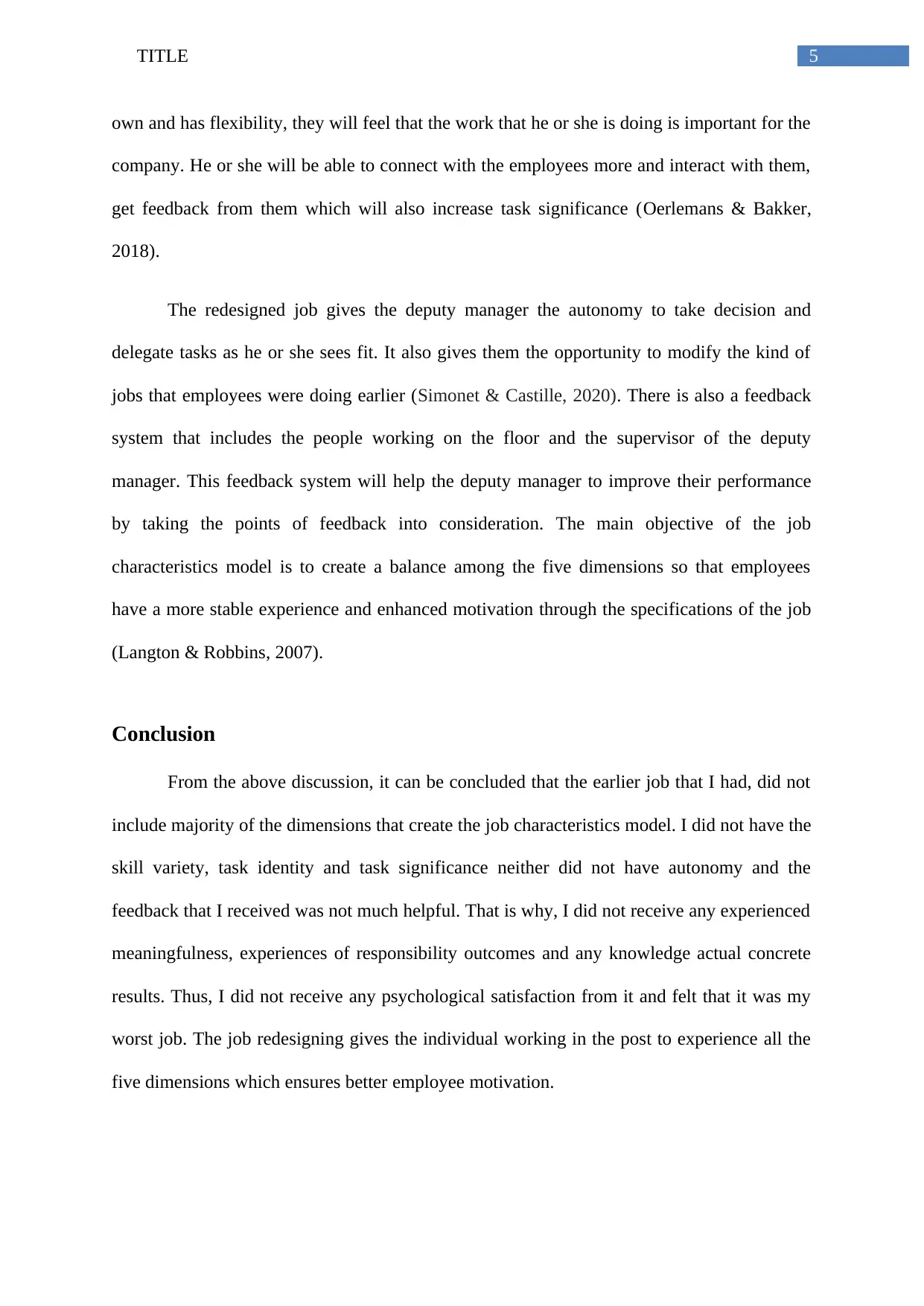
5TITLE
own and has flexibility, they will feel that the work that he or she is doing is important for the
company. He or she will be able to connect with the employees more and interact with them,
get feedback from them which will also increase task significance (Oerlemans & Bakker,
2018).
The redesigned job gives the deputy manager the autonomy to take decision and
delegate tasks as he or she sees fit. It also gives them the opportunity to modify the kind of
jobs that employees were doing earlier (Simonet & Castille, 2020). There is also a feedback
system that includes the people working on the floor and the supervisor of the deputy
manager. This feedback system will help the deputy manager to improve their performance
by taking the points of feedback into consideration. The main objective of the job
characteristics model is to create a balance among the five dimensions so that employees
have a more stable experience and enhanced motivation through the specifications of the job
(Langton & Robbins, 2007).
Conclusion
From the above discussion, it can be concluded that the earlier job that I had, did not
include majority of the dimensions that create the job characteristics model. I did not have the
skill variety, task identity and task significance neither did not have autonomy and the
feedback that I received was not much helpful. That is why, I did not receive any experienced
meaningfulness, experiences of responsibility outcomes and any knowledge actual concrete
results. Thus, I did not receive any psychological satisfaction from it and felt that it was my
worst job. The job redesigning gives the individual working in the post to experience all the
five dimensions which ensures better employee motivation.
own and has flexibility, they will feel that the work that he or she is doing is important for the
company. He or she will be able to connect with the employees more and interact with them,
get feedback from them which will also increase task significance (Oerlemans & Bakker,
2018).
The redesigned job gives the deputy manager the autonomy to take decision and
delegate tasks as he or she sees fit. It also gives them the opportunity to modify the kind of
jobs that employees were doing earlier (Simonet & Castille, 2020). There is also a feedback
system that includes the people working on the floor and the supervisor of the deputy
manager. This feedback system will help the deputy manager to improve their performance
by taking the points of feedback into consideration. The main objective of the job
characteristics model is to create a balance among the five dimensions so that employees
have a more stable experience and enhanced motivation through the specifications of the job
(Langton & Robbins, 2007).
Conclusion
From the above discussion, it can be concluded that the earlier job that I had, did not
include majority of the dimensions that create the job characteristics model. I did not have the
skill variety, task identity and task significance neither did not have autonomy and the
feedback that I received was not much helpful. That is why, I did not receive any experienced
meaningfulness, experiences of responsibility outcomes and any knowledge actual concrete
results. Thus, I did not receive any psychological satisfaction from it and felt that it was my
worst job. The job redesigning gives the individual working in the post to experience all the
five dimensions which ensures better employee motivation.
⊘ This is a preview!⊘
Do you want full access?
Subscribe today to unlock all pages.

Trusted by 1+ million students worldwide

6TITLE
Paraphrase This Document
Need a fresh take? Get an instant paraphrase of this document with our AI Paraphraser
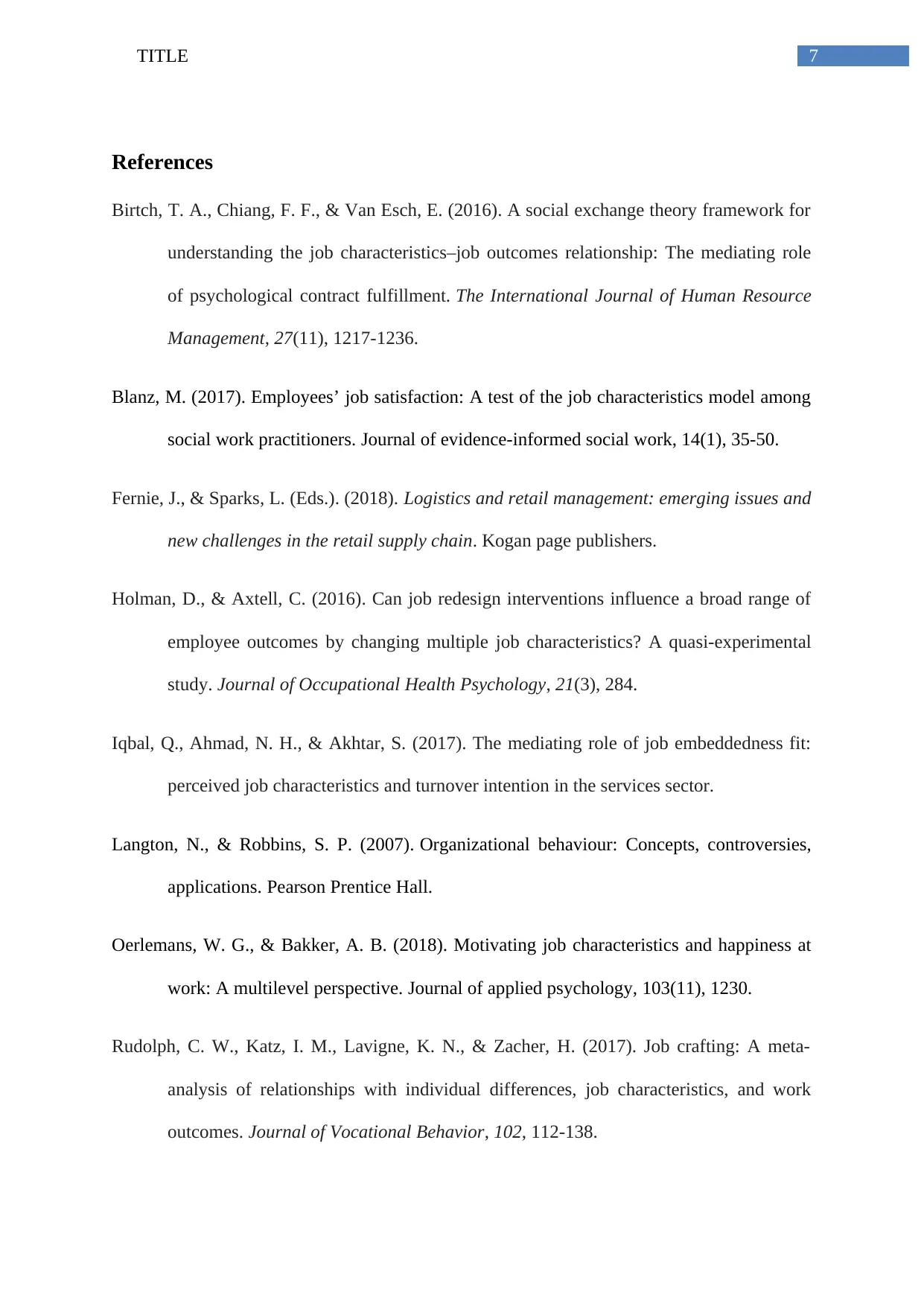
7TITLE
References
Birtch, T. A., Chiang, F. F., & Van Esch, E. (2016). A social exchange theory framework for
understanding the job characteristics–job outcomes relationship: The mediating role
of psychological contract fulfillment. The International Journal of Human Resource
Management, 27(11), 1217-1236.
Blanz, M. (2017). Employees’ job satisfaction: A test of the job characteristics model among
social work practitioners. Journal of evidence-informed social work, 14(1), 35-50.
Fernie, J., & Sparks, L. (Eds.). (2018). Logistics and retail management: emerging issues and
new challenges in the retail supply chain. Kogan page publishers.
Holman, D., & Axtell, C. (2016). Can job redesign interventions influence a broad range of
employee outcomes by changing multiple job characteristics? A quasi-experimental
study. Journal of Occupational Health Psychology, 21(3), 284.
Iqbal, Q., Ahmad, N. H., & Akhtar, S. (2017). The mediating role of job embeddedness fit:
perceived job characteristics and turnover intention in the services sector.
Langton, N., & Robbins, S. P. (2007). Organizational behaviour: Concepts, controversies,
applications. Pearson Prentice Hall.
Oerlemans, W. G., & Bakker, A. B. (2018). Motivating job characteristics and happiness at
work: A multilevel perspective. Journal of applied psychology, 103(11), 1230.
Rudolph, C. W., Katz, I. M., Lavigne, K. N., & Zacher, H. (2017). Job crafting: A meta-
analysis of relationships with individual differences, job characteristics, and work
outcomes. Journal of Vocational Behavior, 102, 112-138.
References
Birtch, T. A., Chiang, F. F., & Van Esch, E. (2016). A social exchange theory framework for
understanding the job characteristics–job outcomes relationship: The mediating role
of psychological contract fulfillment. The International Journal of Human Resource
Management, 27(11), 1217-1236.
Blanz, M. (2017). Employees’ job satisfaction: A test of the job characteristics model among
social work practitioners. Journal of evidence-informed social work, 14(1), 35-50.
Fernie, J., & Sparks, L. (Eds.). (2018). Logistics and retail management: emerging issues and
new challenges in the retail supply chain. Kogan page publishers.
Holman, D., & Axtell, C. (2016). Can job redesign interventions influence a broad range of
employee outcomes by changing multiple job characteristics? A quasi-experimental
study. Journal of Occupational Health Psychology, 21(3), 284.
Iqbal, Q., Ahmad, N. H., & Akhtar, S. (2017). The mediating role of job embeddedness fit:
perceived job characteristics and turnover intention in the services sector.
Langton, N., & Robbins, S. P. (2007). Organizational behaviour: Concepts, controversies,
applications. Pearson Prentice Hall.
Oerlemans, W. G., & Bakker, A. B. (2018). Motivating job characteristics and happiness at
work: A multilevel perspective. Journal of applied psychology, 103(11), 1230.
Rudolph, C. W., Katz, I. M., Lavigne, K. N., & Zacher, H. (2017). Job crafting: A meta-
analysis of relationships with individual differences, job characteristics, and work
outcomes. Journal of Vocational Behavior, 102, 112-138.
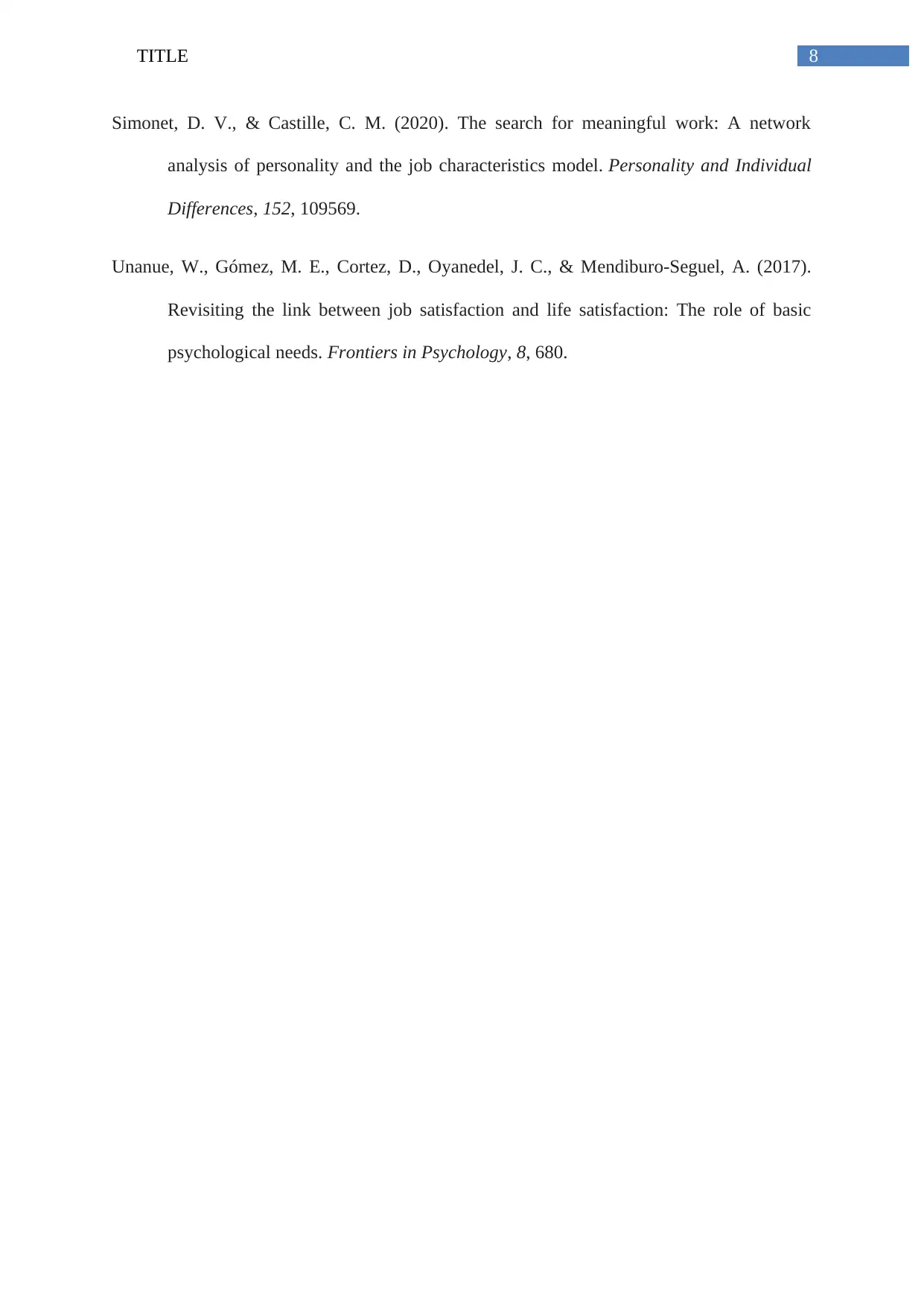
8TITLE
Simonet, D. V., & Castille, C. M. (2020). The search for meaningful work: A network
analysis of personality and the job characteristics model. Personality and Individual
Differences, 152, 109569.
Unanue, W., Gómez, M. E., Cortez, D., Oyanedel, J. C., & Mendiburo-Seguel, A. (2017).
Revisiting the link between job satisfaction and life satisfaction: The role of basic
psychological needs. Frontiers in Psychology, 8, 680.
Simonet, D. V., & Castille, C. M. (2020). The search for meaningful work: A network
analysis of personality and the job characteristics model. Personality and Individual
Differences, 152, 109569.
Unanue, W., Gómez, M. E., Cortez, D., Oyanedel, J. C., & Mendiburo-Seguel, A. (2017).
Revisiting the link between job satisfaction and life satisfaction: The role of basic
psychological needs. Frontiers in Psychology, 8, 680.
⊘ This is a preview!⊘
Do you want full access?
Subscribe today to unlock all pages.

Trusted by 1+ million students worldwide
1 out of 9
Related Documents
Your All-in-One AI-Powered Toolkit for Academic Success.
+13062052269
info@desklib.com
Available 24*7 on WhatsApp / Email
![[object Object]](/_next/static/media/star-bottom.7253800d.svg)
Unlock your academic potential
Copyright © 2020–2025 A2Z Services. All Rights Reserved. Developed and managed by ZUCOL.





